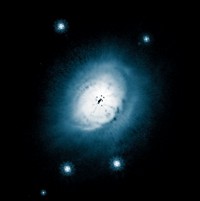Advertisement
Grab your lab coat. Let's get started
Welcome!
Welcome!
Create an account below to get 6 C&EN articles per month, receive newsletters and more - all free.
It seems this is your first time logging in online. Please enter the following information to continue.
As an ACS member you automatically get access to this site. All we need is few more details to create your reading experience.
Not you? Sign in with a different account.
Not you? Sign in with a different account.
ERROR 1
ERROR 1
ERROR 2
ERROR 2
ERROR 2
ERROR 2
ERROR 2
Password and Confirm password must match.
If you have an ACS member number, please enter it here so we can link this account to your membership. (optional)
ERROR 2
ACS values your privacy. By submitting your information, you are gaining access to C&EN and subscribing to our weekly newsletter. We use the information you provide to make your reading experience better, and we will never sell your data to third party members.
Astrochemistry
Ice reactions could have helped form Titan’s dunes
Lab experiments demonstrate how cosmic radiation converts acetylene to polycyclic aromatic hydrocarbons
by Sam Lemonick
October 23, 2019
| A version of this story appeared in
Volume 97, Issue 42
On Saturn’s moon Titan, the lakes, seas, and rain are made from hydrocarbons, not water. The moon even has hydrocarbon dunes, standing 100 m high. Until now, scientists have proposed that reactions in Titan’s atmosphere produced the dunes’ particles, but new laboratory experiments suggest that cosmic radiation interacting with acetylene ice on the moon’s surface could provide another explanation (Sci. Adv. 2019, DOI: 10.1126/sciadv.aaw5841).
One clue that atmospheric reactions might not be the only source of the dune hydrocarbons is that observations suggest the dunes’ particles are more than 100 times as large as what atmospheric chemistry can produce. Ralf Kaiser and colleagues at the University of Hawai‘i at Mānoa decided to test an alternative origin with a lab experiment that simulates the effect of galactic cosmic radiation (GCR) on acetylene ices, which are thought to exist on Titan’s surface in the same areas as the dunes.
GCR itself doesn’t have enough energy to initiate ring-forming reactions from acetylene, but electrons that GCR knocks out of molecules in the ices could. The researchers bombarded acetylene ices at 5 K and very low pressure with electrons, and spectroscopically observed the formation of benzene, three-ringed phenanthrene, and other polycyclic aromatic hydrocarbons. Kaiser says the dunes’ color indicates that they contain larger PAHs than those made in the lab, but the team plans to test whether a longer reaction process could build up molecules with more rings.
Ralph Lorenz of Johns Hopkins University doesn’t question the researchers’ chemistry, but points out that Titan’s atmospheric chemistry is so rich that we might not need another explanation for the dunes’ source. He suggests that some process on the moon’s surface or seas might aggregate organic particles to the size of those found in the dunes. Lorenz is part of a NASA project to land a robot near Titan’s dunes, which he and Kaiser agree could help answer these questions.
CORRECTION
This story was updated on Oct. 25, 2019, to clarify the photograph caption. Titan's dunes are made of a range of hydrocarbons, not just polycyclic aromatic hydrocarbons.




Join the conversation
Contact the reporter
Submit a Letter to the Editor for publication
Engage with us on Twitter